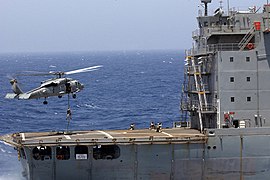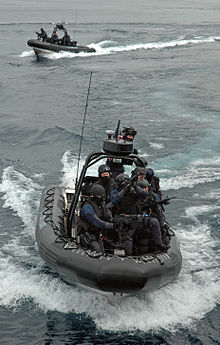
A Marine expeditionary unit is the smallest air-ground task force (MAGTF) in the United States Fleet Marine Force. Each MEU is an expeditionary rapid reaction force ready to any crisis, whether it be disaster aid or a combat mission. Marine amphibious unit (MAU) was the name used until the late 1980s.

USS New Orleans (LPD-18), a San Antonio-class amphibious transport dock, is the fourth commissioned ship of the United States Navy to be named after the city of New Orleans, Louisiana.

Force Reconnaissance (FORECON) is a United States Marine Corps special operations forces which supplies military intelligence to the command element of the Marine Air-Ground Task Force (MAGTF). Force Reconnaissance companies unlike USMC division reconnaissance report to the Marine expeditionary force (MEF) and provide direct action and deep reconnaissance during large-scale operations.

A Maritime Safety and Security Team, or MSST, is a counter-terrorism team of the United States Coast Guard established to protect local maritime assets. It is also a harbor and inshore patrol and security team that includes detecting and, if necessary, stopping or arresting submerged divers, using the Underwater Port Security System. It is the only special force that can arrest submerged divers.
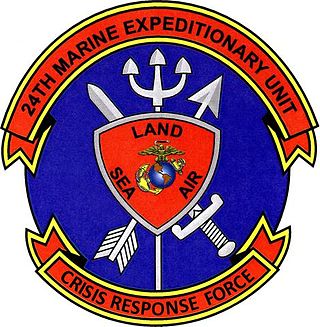
The 24th Marine Expeditionary Unit is one of seven Marine Expeditionary Units currently in existence in the United States Marine Corps. The Marine Expeditionary Unit is a Marine Air Ground Task Force (MAGTF) with a strength of about 2,200 personnel. The MEU consists of a Command Element, a Ground Combat Element based on a reinforced infantry battalion, an Aviation Combat Element based on a reinforced tiltrotor squadron, and a Logistics Command Element based on a Combat Logistics Battalion. The 24th MEU is currently based out of Marine Corps Base Camp Lejeune, North Carolina.
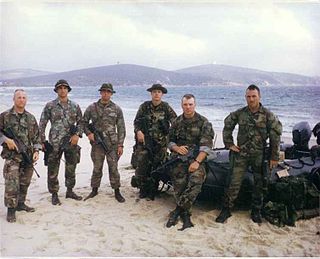
The Radio Reconnaissance Platoon is a specially trained Marine Corps Intelligence element of a United States Marine Corps Radio Battalion. A Radio Reconnaissance Team (RRT) was assigned as the tactical signals intelligence collection element for the Marine Corps Special Operations Command, Detachment One. Regular RRTs also participate in SOC operations during Marine Expeditionary Unit, or MEU(SOC), deployments.
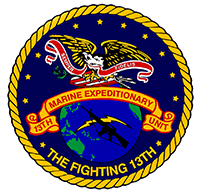
The 13th Marine Expeditionary Unit is one of seven Marine Expeditionary Units currently in existence in the United States Marine Corps. The Marine Expeditionary Unit is a Marine Air Ground Task Force with a strength of about 2,200 personnel. The MEU consists of a command element, a reinforced infantry battalion, a composite aviation squadron and a combat logistics battalion. The 13th MEU is currently based out of Marine Corps Base Camp Pendleton, California.

The 15th Marine Expeditionary Unit is one of seven such units currently in existence in the United States Marine Corps. The Marine Expeditionary Unit (MEU) is a Marine Air Ground Task Force (MAGTF) with a strength of about 2,200 personnel. The MEU consists of a command element, a reinforced infantry battalion, a composite helicopter squadron and a combat logistics battalion. The 15th MEU is currently based out of Marine Corps Base Camp Pendleton, California.

Law Enforcement Detachments or LEDETs are specialized, deployable maritime law enforcement teams of the United States Coast Guard. First established in 1982, their primary mission is to deploy aboard U.S. and allied naval vessels to conduct and support maritime law enforcement, interdiction, or security operations. LEDETs are the operational elements of the Coast Guard’s two Tactical Law Enforcement Teams (TACLETs) which were part of the Coast Guard’s Deployable Operations Group (DOG) from 2007 to 2013. As of April 2010 there are seventeen LEDETs.
The United States Coast Guard is the coastal defense, search and rescue, and maritime law enforcement branch of the United States Armed Forces and is one of the country's eight uniformed services. It carries out three basic roles, which are further subdivided into eleven statutory missions. The three roles are:
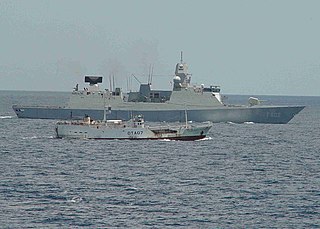
Maritime security operations (MSO) are the actions of modern naval forces to "combat sea-based terrorism and other illegal activities, such as hijacking, piracy, and slavery, also known as human trafficking." Ships assigned to such operations may also assist seafaring vessels in distress. These activities are part of an overall category of activities which fall short of open warfare called military operations other than war (MOOTW). MSO also involve the marine environmental protection, creating a safer and clean environment.

The Joint Maritime Training Center (JMTC), also known as the Special Missions Training Center (SMTC), is a joint United States Coast Guard, Navy, and Marine Corps training facility located on Camp Lejeune, North Carolina. JMTC's mission is to provide relevant and credible Maritime Security Training and Operational Testing and Evaluation in support of Department of Defense and Department of Homeland Security missions. JMTC comprises four main divisions: Weapons, Port Security, Engineering / Logistics, and Fast Boat.

The Marine Corps Security Force Regiment is a dedicated security and anti-terrorism unit of the United States Marine Corps. It provides security forces to guard high-value naval installations, most notably those containing nuclear vessels and weapons. It also provides Fleet Anti-terrorism Security Teams (FAST) and Recapture Tactics Teams (RTT). Marines who complete Security Forces training are assigned a secondary Military Occupational Specialty (MOS) of 8152, while instructors can earn 8153.

A Maritime Special Purpose Force (MSPF) is a United States Marine Corps specialized sub-unit of a Marine expeditionary unit. A MSPF is deployed to give the commanders low profile, two-platoon surgical emplacement in the accessible littoral regions. The MSPF provides the enhanced operational capability and precision skills to complement, enable, and execute selected conventional, maritime special operations. They can also perform operations not resident in traditional amphibious raid companies.

Marine expeditionary unit (special operations capable) (MEU(SOC)) was a program created by the United States Marine Corps and the United States Navy in 1985 for Marine expeditionary units (MEU). As of 2013 the term MEU(SOC) is obsolete. The program enhanced MEUs providing them with additional training and equipment to become certified as special operations capable with a Maritime Special Purpose Force (MSPF). The designation special operations capable was unique to the Marine Corps and meant in relation to special operations. The role of a MEU(SOC) however was not equivalent to the special operations role of special operations forces. Although considered special operations capable a MEU(SOC) did not form part of the United States Special Operations Command (USSOCOM) established in 1987 or the United States Marine Forces Special Operations Command (MARSOC) later established in 2006.

1st Force Reconnaissance Company conducts deep reconnaissance and direct action raids in support of I Marine Expeditionary Force requirements across the range of military operations to include crisis response, expeditionary operations and major combat operations. 1st Force Recon Company was deactivated 26 October 2006 and the majority of the personnel were used to create 1st Marine Special Operations Battalion.

The Deployable Operations Group (DOG) was a United States Coast Guard command that provided properly equipped, trained and organized Deployable Specialized Forces (DSF), which still exist today, to the Coast Guard, United States Department of Homeland Security (DHS), United States Department of Defense (DoD) and inter-agency operational and tactical commanders. Formerly headquartered in Arlington, Virginia, it was established on 20 July 2007, and was commanded by a captain and was decommissioned by the Commandant of the Coast Guard, Admiral Robert Papp on 1 October 2013, although many of the units existed long before the 2007 commissioning. Upon decommissioning, the units previously assigned to the DOG were split between Coast Guard Pacific and Atlantic Area commands.
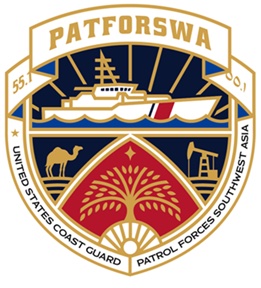
Patrol Forces Southwest Asia (PATFORSWA) is a United States Coast Guard command based in Manama, Bahrain. PATFORSWA was created in November 2002 as a contingency operation to support the U.S. Navy with patrol boats. The command's mission is to train, equip, deploy and support combat-ready Coast Guard forces conducting operations in support of Operation Iraqi Freedom (OIF), Operation Enduring Freedom (OEF) and Operation Inherent Resolve (OIR) in the Naval Forces Central Command's area of responsibility. It was commissioned as a permanent duty station in June 2004. In July 2003 PATFORSWA moved from its own compound to facilities at Naval Support Activity Bahrain.

ATLS-9701 is a small unnamed U.S. Navy active service auxiliary Aerial Target Launch Ship operated by the Pacific Targets and Marine Operations Division (PTMO), U.S. Department of the Navy. The ship possesses VHF, UHF, Sat-Phone, NIPR/SIPRNET communication capabilities, equipped with Nobeltec Navigation system, and BQM-74 aerial targets launchers.

